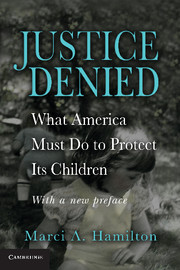Book contents
- Frontmatter
- Contents
- Acknowledgments
- 1 We Have Failed Our Children
- 2 What Is Wrong with the System? The Courthouse Doors Are Closed to Survivors
- 3 The Solution Is Clear and Simple: Abolish the Statutes of Limitation for Childhood Sexual Abuse
- 4 What It Will Take to Protect Children: What the States Must Do; What the Federal Government Should Do
- 5 Barrier #1: The Insurance Industry
- 6 Barrier #2: The Hierarchy of the Roman Catholic Church
- 7 The Other Barriers: Teachers, Defense Attorneys, and an Uninformed Public
- Conclusion: The Coming Civil Rights Movement for Children
- Appendix to Chapter 4
- Appendixes to Chapter 6
- Notes
- Index
2 - What Is Wrong with the System? The Courthouse Doors Are Closed to Survivors
Published online by Cambridge University Press: 03 May 2010
- Frontmatter
- Contents
- Acknowledgments
- 1 We Have Failed Our Children
- 2 What Is Wrong with the System? The Courthouse Doors Are Closed to Survivors
- 3 The Solution Is Clear and Simple: Abolish the Statutes of Limitation for Childhood Sexual Abuse
- 4 What It Will Take to Protect Children: What the States Must Do; What the Federal Government Should Do
- 5 Barrier #1: The Insurance Industry
- 6 Barrier #2: The Hierarchy of the Roman Catholic Church
- 7 The Other Barriers: Teachers, Defense Attorneys, and an Uninformed Public
- Conclusion: The Coming Civil Rights Movement for Children
- Appendix to Chapter 4
- Appendixes to Chapter 6
- Notes
- Index
Summary
The law has been structured so that child predators rarely have to face the legal system for their despicable acts. Justice has been difficult for child sex abuse survivors to obtain because the courthouse doors have been padlocked before they arrived. For decades, the states organized their legal systems in a way that almost always favored the perpetrator by keeping the survivor out of court. When a survivor was finally ready and tapped on the courthouse door, there was no answer, so the survivor quietly retreated. Forget getting survivors' claims before a jury – actions filed by the few brave souls who came forward were usually blocked from the very start by the statutes of limitations (SOLs). Sitting silently behind those few who tried to find justice, but could not, were the millions who never came forward. There were no incentives to draw victims to the courts.
It was not uncommon twenty years ago for states to impose a mere two-year SOL on legal actions concerning childhood sexual abuse, which meant that a child abused at age seven would have to get to court by age nine or else lose the right to sue. There was a lot to lose, including justice and public vindication. If the courts were available, survivors would have two paths to justice and vindication – criminal prosecution and civil actions. Both forums validate the survivor and get the truth to the public.
- Type
- Chapter
- Information
- Justice DeniedWhat America Must Do to Protect its Children, pp. 15 - 20Publisher: Cambridge University PressPrint publication year: 2008



